|
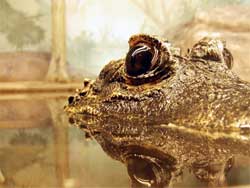 Mysterious Beasts: Although the Caiman has not been studied in-depth, it has been discovered that their mating cycles (previously thought to be spontaneous or year-round) are linked to the rainfall cycles and the river levels in order to increase their offspring's chances of survival. Mysterious Beasts: Although the Caiman has not been studied in-depth, it has been discovered that their mating cycles (previously thought to be spontaneous or year-round) are linked to the rainfall cycles and the river levels in order to increase their offspring's chances of survival.
The Black Caiman: The Black Caiman (Melanosuchus niger) is a threatened species, related to alligators. It is a carnivorous reptile that lives along slow-moving rivers and lakes, in the seasonally flooded savannas of the Amazon basin, and in other freshwater habitats in South America. Once common, it was hunted to near extinction primarily for its commercially valuable hide. 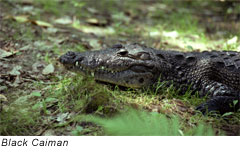 The Black Caiman has a bony ridge over red eyes, and black, scaly skin. The skin coloration helps with camouflage during its nocturnal hunts, but may also help absorb heat. In December, females build a nest of soil and vegetation, which is about 5 feet across and 2.5 feet wide. They lay from 50 to 60 eggs, which hatch in about six weeks. They sometimes eat their young. Their main predator is humans, who hunt them for leather or meat. The Black Caiman has a bony ridge over red eyes, and black, scaly skin. The skin coloration helps with camouflage during its nocturnal hunts, but may also help absorb heat. In December, females build a nest of soil and vegetation, which is about 5 feet across and 2.5 feet wide. They lay from 50 to 60 eggs, which hatch in about six weeks. They sometimes eat their young. Their main predator is humans, who hunt them for leather or meat.
The Black Caiman can grow to about 6 meters (20 feet) in length, and is both the largest member of the Alligatoridae family and the Amazon's largest predator. They eat fish, including piranhas, electric eels, birds, turtles, and land-dwelling animals like the capybara and deer when they come to the water to get a drink. Larger specimens can take tapirs, pumas, anacondas and jaguars. Their teeth are designed to grab but not rip, so they swallow their food whole after drowning it. Immature specimens eat crustaceans and insects. Healthy adult black caimans have no predators other than humans and one of the apex predator in its habitat. The caiman's excrement was once a substantial food source for the plankton which form the base of the aquatic Amazonian food chain, and their rarity has thus led to a concomitant decline of many species, including some that provide an important food source for humans.
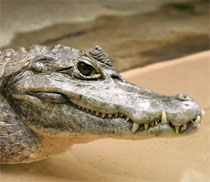 The Spectacled Caiman: C. crocodilus, the Spectacled Caiman, has the widest distribution, from southern Mexico to the northern half of Argentina, and grows to a modest size of about 7 feet. The largest, attaining an enormous bulk and a length of 20 ft., is the near-threatened Melanosuchus niger, the Jacare-assu, Large, or Black Caiman of the Amazon. The Black Caiman and American Alligator are the only members of the alligator family posing the same danger to humans as the larger species of the crocodile family. The Spectacled Caiman: C. crocodilus, the Spectacled Caiman, has the widest distribution, from southern Mexico to the northern half of Argentina, and grows to a modest size of about 7 feet. The largest, attaining an enormous bulk and a length of 20 ft., is the near-threatened Melanosuchus niger, the Jacare-assu, Large, or Black Caiman of the Amazon. The Black Caiman and American Alligator are the only members of the alligator family posing the same danger to humans as the larger species of the crocodile family.
The Spectacled Caiman (Caiman crocodilus) is a crocodilian reptile found in much of Central and South America. It lives in a range of lowland wetland and riverine habitat types and can tolerate salt water as well as fresh; due in part to this adaptability it is the most common of all crocodilian species. Males of the species are generally between 2 and 2.5 meters, while females are smaller, usually around 1.4 meters. The species' common name comes from a bony ridge between the eyes, which gives the appearance of a pair of spectacles.
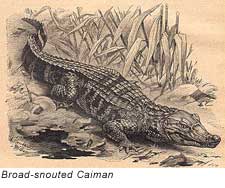 The Broad-snouted Caiman: The Broad-snouted Caiman (Caiman latirostris) is a crocodilian reptile found in parts of South America. It is found mostly in freshwater marshes, swamps, and mangroves. Its notable physical characteristic is its broad snout from which its name is derived. Most tend to be of an olive-green color, with exceptions occurring as adaptations to varying climates. Its diet consists mainly of small invertebrates, and it can crush shells to feed on turtles and snails. The species is threatened due to illegal hunting and loss of habitat. The Broad-snouted Caiman: The Broad-snouted Caiman (Caiman latirostris) is a crocodilian reptile found in parts of South America. It is found mostly in freshwater marshes, swamps, and mangroves. Its notable physical characteristic is its broad snout from which its name is derived. Most tend to be of an olive-green color, with exceptions occurring as adaptations to varying climates. Its diet consists mainly of small invertebrates, and it can crush shells to feed on turtles and snails. The species is threatened due to illegal hunting and loss of habitat.
The Cuvier's Dwarf Caiman: The Cuvier's Dwarf Caiman (Paleosuchus palpebrosus) is a crocodilian reptile from South America. It is found in Bolivia, Brazil, Colombia, Ecuador, French Guiana, Guyana, Paraguay, Peru, Surinam and Venezuela. It is also the smallest species of the alligatoridae family reaching up to 1.5 meters of length.
The Smooth-fronted Caiman: The Smooth-fronted Caiman (Paleosuchus trigonatus) is a crocodilian reptile from South America. It is found in Bolivia, Brazil, Colombia, Ecuador, French Guiana, Guyana, Peru, Suriname and Venezuela. It is also the second smallest species of the alligatoridae family reaching up to 2.3 meters of length.
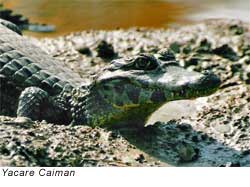 The Yacare Caiman: The Yacare Caiman (Caiman yacare, Jacaré in Portuguese) is a caiman found in central South America, including northern Argentina, southern Bolivia, south-west Brazil (especially in the Pantanal marshland), and the rivers of Paraguay. The Yacare Caiman: The Yacare Caiman (Caiman yacare, Jacaré in Portuguese) is a caiman found in central South America, including northern Argentina, southern Bolivia, south-west Brazil (especially in the Pantanal marshland), and the rivers of Paraguay.
All text is available under the terms
of the GNU Free Documentation License |